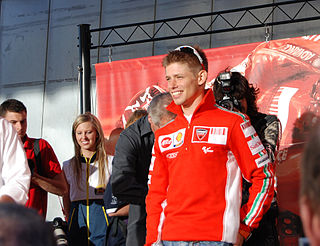
Grand Prix motorcycle racing is the highest class of motorcycle road racing events held on road circuits sanctioned by the Fédération Internationale de Motocyclisme (FIM). Independent motorcycle racing events have been held since the start of the twentieth century and large national events were often given the title Grand Prix. The foundation of the Fédération Internationale de Motocyclisme as the international governing body for motorcycle sport in 1949 provided the opportunity to coordinate rules and regulations in order that selected events could count towards official World Championships. It is the oldest established motorsport world championship.
Scuderia Ferrari is the racing division of luxury Italian auto manufacturer Ferrari and the racing team that competes in Formula One racing. The team is also known by the nickname "The Prancing Horse", in reference to their logo. It is the oldest surviving and most successful Formula One team, having competed in every world championship since 1950.

Pierre Raymond Sommer was a French racing driver. He raced both before and after WWII with some success, particularly in endurance racing. He won the 24 Hours of Le Mans endurance race in both 1932 and 1933, and although he did not reach the finishing line in any subsequent appearance at the Le Mans, he did lead each event until 1938. Sommer was also competitive at the highest level in Grand Prix motor racing, but did not win a race. He won the French Grand Prix in 1936, but the event that year was run as a sports car race.
Grand Prix motor racing, a form of motorsport competition, has its roots in organised automobile racing that began in France as early as 1894. It quickly evolved from simple road races from one town to the next, to endurance tests for car and driver. Innovation and the drive of competition soon saw speeds exceeding 100 miles per hour (160 km/h), but because early races took place on open roads, accidents occurred frequently, resulting in deaths both of drivers and of spectators. A common abbreviation used for Grand Prix racing is "GP" or "GP racing".

The 1950 British Grand Prix, formally known as The Royal Automobile Club Grand Prix d'Europe Incorporating The British Grand Prix, was a Formula One motor race held on 13 May 1950 at the Silverstone Circuit in Silverstone, England. It was the first World Championship Formula One race, as well as the fifth British Grand Prix, and the third to be held at Silverstone after motor racing resumed after World War II. It was the first race of seven in the 1950 World Championship of Drivers.
The 1949 Grand Prix motorcycle racing season was the inaugural F.I.M. Road Racing World Championship Grand Prix season. The season consisted of six Grand Prix races in five classes: 500cc, 350cc, 250cc, 125cc and Sidecars 600cc. It began on 17 June, with Isle of Man TT and ended with Nations Grand Prix on 4 September.

The 1950 Grand Prix motorcycle racing season was the second F.I.M. Road Racing World Championship Grand Prix season. The season consisted of six Grand Prix races in five classes: 500cc, 350cc, 250cc, 125cc and Sidecars 600cc. It began on 10 June, with Isle of Man TT and ended with Nations Grand Prix on 10 September.

The 1951 Grand Prix motorcycle racing season was the third F.I.M. Road Racing World Championship Grand Prix season. The season consisted of eight Grand Prix races in five classes: 500cc, 350cc, 250cc, 125cc and Sidecars 500cc. It began on 8 April, with Spanish Grand Prix and ended with Nations Grand Prix on 9 September. As of 2022, this is the most recent season the premier class was won by a non-Japanese or non-Italian constructor.

The 1953 Grand Prix motorcycle racing season was the fifth F.I.M. Road Racing World Championship Grand Prix season. The season consisted of nine Grand Prix races in five classes: 500cc, 350cc, 250cc, 125cc and Sidecars 500cc. It began on 12 June, with Isle of Man TT and ended with Spanish Grand Prix on 4 October.

The 1949 Isle of Man Tourist Trophy was the first round of the Grand Prix World Championship that was held in the Isle of Man.

The 2007 Grand Prix motorcycle racing season was the 59th F.I.M Road Racing World Championship season. The season consisted out of 18 races for the MotoGP class and 17 for the 125cc and 250cc classes, beginning with the Qatar motorcycle Grand Prix on 10 March 2007 and ending with the Valencian Community motorcycle Grand Prix on 4 November.
The 107% rule is a sporting regulation affecting Formula One racing qualifying sessions. During the first phase of qualifying, if the circuit is dry, any driver who is eliminated in the first qualifying session and fails to set a lap within 107% of the fastest time in that session will not be allowed to start the race without permission from the race stewards. For example, if the fastest Q1 lap time was 100 seconds, each driver who is eliminated in the session must complete at least one lap within 107 seconds to guarantee a race start. The 107% rule was introduced for the 1996 season and remained in force until 2002. It was reintroduced for the 2011 season with minor modifications due to the knock-out qualifying format.







